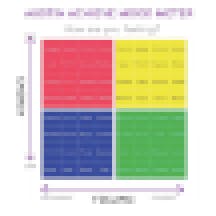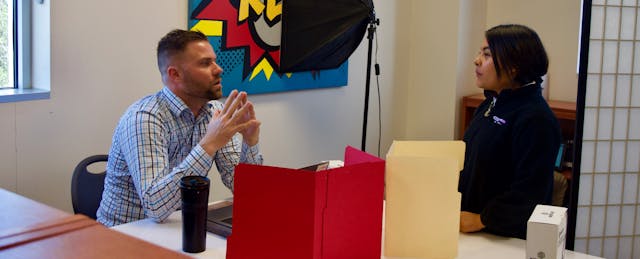AUSTIN, Texas — Even in elementary school, Luz Annette got into a lot of fights with other girls. In the hallways, in the cafeteria, in the girls’ restroom. Just about every day brought another confrontation.
These were not just shouting matches. Luz, who is now in eighth grade, was getting into physical altercations with her classmates.
“When you get in an argument, you just straight up go and fight,” the 14-year-old says, describing a lesson that was ingrained in her at a young age.
But Luz doesn’t get in fights anymore—not since the one she was involved in at the beginning of the school year, which she says was her last.
At her old school, the teachers might have broken up the fight and sent her to in-school suspension—a standard disciplinary response to altercations where “they just take you to this room and then you have to be quiet and do work” for several hours, sometimes several days in a row, she says. (She’s been in such rooms many times before at other schools.)
But at Austin Achieve Public Schools, a K-12 school where Luz is enrolled now, in-school suspension is not an option. In fact, the school stopped suspending students altogether in 2015, after administrators realized the practice was denying their most at-risk students important social, emotional and academic reinforcements.
Instead, the public charter school has embraced “restorative justice,” an alternative disciplinary approach that exposes students to mindfulness exercises, one-on-one counseling and group therapy sessions with a social worker.
Restorative justice emphasizes repairing harm, rebuilding relationships and rehabilitating the offender over meting out punishments for infractions. As more research and case studies come out in support of restorative justice programs, schools are increasingly turning to the approach to reduce suspension rates (which disproportionately affect students of color) and improve graduation rates.
“At most schools, when kids do something suspension-worthy, you take away support,” says Reece Hartle, the middle school principal at Austin Achieve. “At our school, they get more support.”
The program has transformed the culture of the school, officials say, and it’s changed the way students like Luz handle conflict and manage their emotions.
A ‘Critical Need’
Located in the rapidly-gentrifying East Austin neighborhood, Austin Achieve was founded in 2012 by John Armbrust, a Teach for America alumnus, to set a new bar for what schools in the area could be.

Armbrust, who had taught in Atlanta and Los Angeles, zeroed in on East Austin as a neighborhood in “chronic need” of a high-quality option. The schools were consistently underperforming; the middle school most Austin Achieve students were zoned for, he says, was the lowest-performing school in the state of Texas the year Austin Achieve opened. He wanted something better for local families.
Austin Achieve is tuition-free and open enrollment. Nearly all of its 1,500 students are Latino and designated as low-income. Most will be the first in their families to go to college—an expressed goal of the school staff, who set high expectations for both behavior and academics.
In its first three years of operation, Austin Achieve responded to disciplinary violations the way many schools do: with in-school suspension, out-of-school suspension and expulsion, all of which would show up on a student’s record.
“One of the things we saw” early on, says Emily Morrison, the chief advancement officer, is that “our most at-risk scholars—those facing pregnancy, homelessness, issues at home—were also the ones affected by our zero-tolerance approach to discipline.”
In short, the students who were most frequently suspended were the same ones Austin Achieve was designed to serve.
“I didn't start a school to serve a bunch of kids who are going to make it on their own without me,” Armbrust says. “I started this school to serve a certain population.”
The school administrators then faced an existential quandary. Were they living up to their mission? Was Austin Achieve serving its intended purpose?
Armbrust and his staff visited schools across the U.S., including ones in Nashville and San Antonio, that better supported students socially and emotionally. Through those visits, they realized “a critical need” for Austin Achieve, Armbrust says, and began thinking about how they could weave those practices into their own, homegrown program.
In the end, they decided to shift from the zero-tolerance policy they had started with to a program that keeps students in school. “We decided if we have children who are facing difficulties, we need to provide them with programs and opportunities for remedying those situations,” Morrison says, “because in some cases, going home doesn’t help them to restore, get better and grow.”
RJ in Action
Shortly after the start of this school year, when Luz ran into a girl she had not been getting along with on her way to the restroom, her instinct was to fight her. But when she and the girl lunged at each other, their friends and Hartle, the principal, saw what was happening and jumped in to separate them.
Luz, as a result, was assigned to the restorative justice program, or RJ, as it’s known at Austin Achieve.
Few students are admitted to RJ for a single offense, Hartle says. It happens when there’s a physical altercation or when students bring drugs or other contraband to school. In most cases, students are sent to RJ after a series of episodes in which they’ve acted out or shown disrespect to their peers or teachers. “It comes out in different ways,” he says, and is usually the last resort for students after trying a number of other interventions focused around conflict resolution.
One of the first things Luz did every day during her three weeks in RJ was work on her proposal—a multi-page document that, when complete, outlines what she did wrong, who was affected, what she learned in RJ, any tools and techniques she acquired to address the source of the problem and how she plans to use those moving forward. When students like Luz think they’re ready to leave the program, they present their proposal to a panel of peers, which is made up of “ambassadors” at Austin Achieve who have been selected and trained for this purpose.
Students in RJ are expected to keep up with their regular class work, which is supported by a blended learning program the school instituted in the second year of RJ, after the teachers observed that students were falling behind. As a result, they spend a significant amount of time in RJ working on their assignments.
The rest of the day is devoted to what the school deems restorative practices, including a morning circle and a closing circle—group conversations themed around why the students are in RJ. This is when students have a chance to talk to each other about what’s going on in their lives and why they are struggling.
“It was gorgeous,” Luz gushes. “[The other students] talk about their problems and then you’re, like, ‘Oh, same,’ you know? And that was literally the best—that we had a trust in that circle. We can tell, like, everything in there—we can compare our problems and then we can help each other.”

They also have a daily lesson around social-emotional learning and another on mindfulness, which can involve yoga lessons, guided meditations and music therapy.
During her time in RJ, Luz’s opinion of the program improved. At first she thought it was “boring” and didn’t take it very seriously. But she began to see the merits of the exercises she was doing.
For example, the two RJ coordinators encouraged Luz and the girl she tried to fight to talk through their conflict. The two had been friends years ago, and after going through the RJ program together, they are getting along again. “With her, I made, like, a bond,” Luz says.
She also took away some practical techniques for managing her anger, she says. One of the things she learned is impulse control. Now, when she gets mad, she counts to 10 in her head before responding. She also has the option of going in to the RJ classroom at any time to talk through her feelings with one of the coordinators.
The whole experience has given her a new perspective.
“It's just like a silly thing right now, getting in a fight,” she says proudly, echoing her teachers. “And then we’re about to go to high school, and it's just, like, I'm thinking right now of going to college. Ten years later, I’m not going to care about a fight.”
Introducing School-Wide Restorative Practices
The school staff has had to adjust and iterate on the RJ program multiple times since its launch. They shortened the average length of stay for students in RJ, from nearly a month to about two weeks. They’ve improved the instructional element, too. In addition to better utilizing blended learning, the school also requires that teachers check in with their students in RJ at least once a week during their planning period.
The RJ classroom is isolated from most academic classrooms on campus, but it doesn’t look all that different from them. The room features whiteboards, a projector and standard desks. But it also has several couches, two dedicated teachers (the RJ coordinators, who work full-time on the program) and typically no more than eight to 10 students at a time.


“Having a five-to-one staffing ratio is not sustainable if we were doing that everywhere,” Armbrust acknowledges, “so it’s showing the world this is our priority. We’re going to spend some full-time salary dollars on this person because it’s important.”
But the school’s embrace of a restorative justice program didn’t just benefit the students with the greatest need. Shortly after Austin Achieve launched an RJ program, it also introduced a social-emotional learning (SEL) curriculum to all students across all grades.
“We saw the restorative practices working in the smaller pilot environment for the most at-risk kiddos and thought, ‘This should be something that we do district-wide,’” Morrison says.
During those SEL lessons, students learn about emotional intelligence and how their brains work so they can better talk about what they’re feeling and why they may be feeling that way. They tailor these lessons to each age group, Morrison says. So elementary students, for example, learn about good and bad decision-making through the lens of their “wizard brains” and their “lizard brains,” respectively.
These lessons are supposed to set up the students to address conflict through honest, open conversations called “restorative circles,” which are practiced widely throughout the school by students who may never see the inside of the RJ classroom.
The circles can happen one-on-one or in a group, and they can address conflict among peers or between students and teachers. A teacher or administrator usually mediates the discussion, asking what happened, why it happened and what techniques the students have learned in their SEL classes to be able to overcome the conflict or repair any harm done. In many ways, the circle is a condensed version of the proposal students in RJ have to complete.
The mediator present helps assess the conflict by using a mood meter, which kids can use to identify the emotions they’re experiencing.

“It’s a very different way of discipline because it's not about the adults, and it’s not about immediate fixes,” Hartle says. “It’s been really cool to build the idea that you can … be heard by each other and be able to come up with what each person needs to feel comfortable moving forward.”
The students have transitioned to the circles and the RJ program well, Armbrust says. They take both seriously and are proud of the new school culture it’s created.
“Now, it’s cool to be good,” he says. “And when we enroll new kids, [students] will be like, ‘Yo, that’s not the Austin Achieve way. Like that’s just not how we roll here.’”


